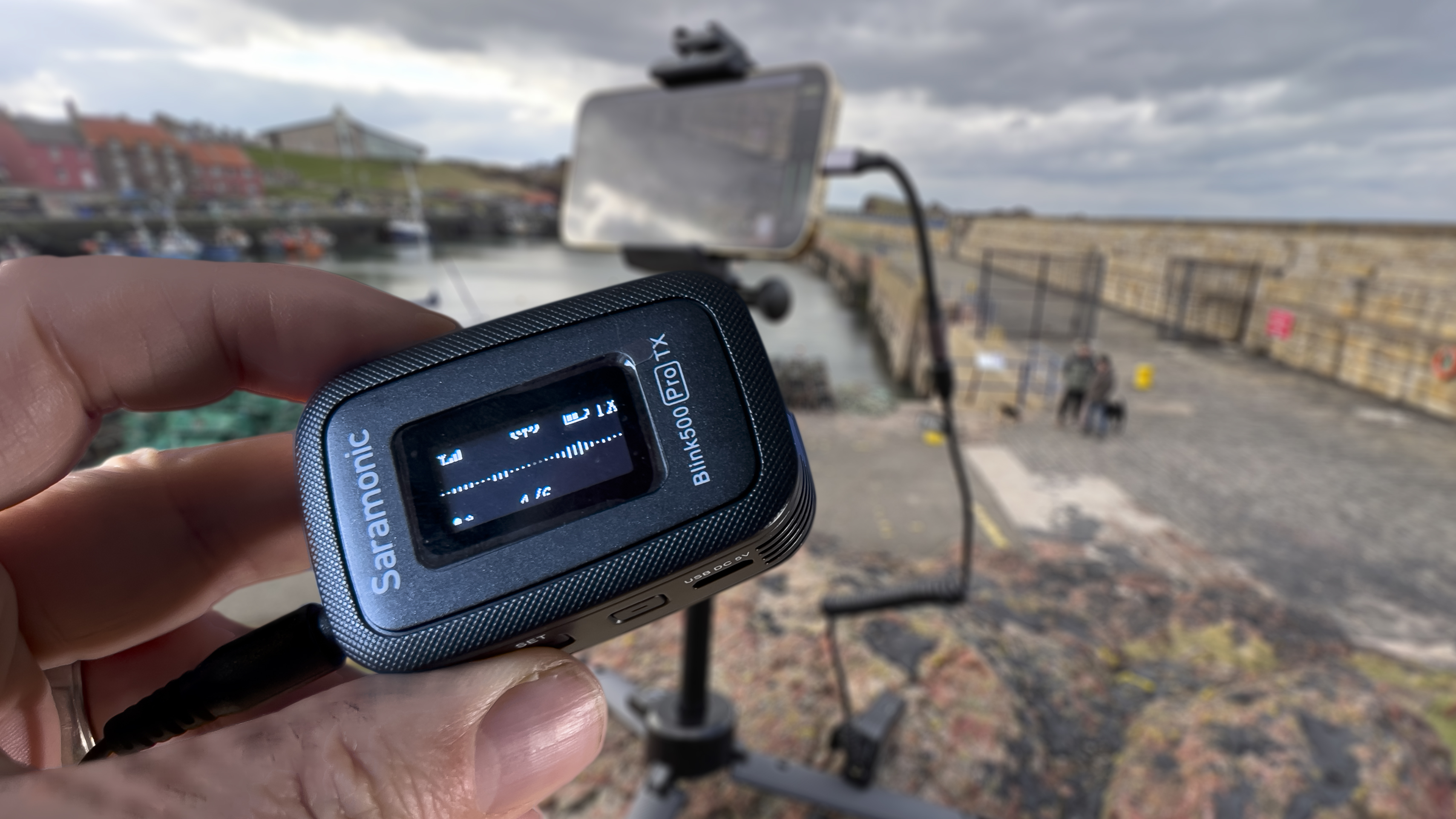Digital Camera World Verdict
The Saramonic Blink500 Pro B2 kit enables you capture strong clean audio levels from up to 100 meters (if the transmitter mics have line of sight with the receiver). The supplied lavalier mics help reduce wind noise in challenging locations. The kit is compact and portable so will easily fit in your kit bag. It’s compatible with DSLRs or smartphones (though you will need a jack-to-Lightning adaptor cable for newer iPhones.) Highly recommended.
Pros
- +
Wind-free audio
- +
Professional quality sound
- +
Long distance transmitters
- +
Compact charging case
Cons
- -
Wind noise when using transmitter’s built-in mic
Why you can trust Digital Camera World
The Saramonic Blink500 Pro 2 system enables you to capture clean full-bodied audio wirelessly, making it perfect for documentary style programmes where the subjects need to walk freely around a location and at a distance from the camera.
If you record audio from your camera’s built-in mic (or from a shotgun mic mounted on the camera body) then your subject needs to be in close proximity to the camera. This type of audio recording set-up might be fine for capturing ambient sound at a wedding but at a distance you’ll struggle to hear the best man’s speech over the clink of cutlery and general chatter using an on-camera mic.
Specifications
Receiver specifications
Digital frequency: 2.4GHz
Modulation: GFSK
Weight: 1.13oz
Range: 100m
Connection: 3.5mm jack
Output level: -60 dBV to -20 dBV
Battery life: 8 hours
Transmitter specifications
Digital frequency: 2.4GHz
Modulation: GFSK modulation
Weight: 1.13oz
Polar pattern: omnidirectional
Battery life: 8 hours
Key features


The key components of the Blink500 Pro B2 kit are two wireless transmitters and a receiver. Each of the three units looks identical, so you could confuse the transmitters from the receiver if you were in a hurry to mic up your subjects. To help identify them the transmitters have a little TX label, while the receiver is labelled RX.
Other similar wireless sets such as the JOBY Wavo AIR have a receiver that looks slightly different in build and colour which helps differentiate between receiver and transmitter more easily.
The three units fit into a protective carry case that also functions as a charger. This means you can charge all three at once in the box via its USB-C DC 5v port using USB-A chargers and battery packs. This is a fantastic feature as all three units will be fully powered and ready for a long shoot as soon as you open the case.
The transmitters in the similar JOBY Wavo AIR need to be charged individually so you run the risk of having a receiver with less power than a transmitter, which could compromise a shoot.
The Blink500 Pro B2’s charging box also has the bonus of a one-click pair button. This instantly pairs the two transmitters with the receiver so they all work straight from the box.
The kit also ships with a couple of wind-shields that you can clip straight onto the transmitters’ built-in mics, plus a very useful pair of lavalier clip mics to capture better quality audio from closer to the subject’s mouth.
Build and handling


The charging case, transmitters and box are all made of a lightweight black plastic. At 1.13 oz in weight the transmitters aren’t going to be a burden once they’re clipped to your subject (or popped in a pocket). Once you power up the transmitters an OLED display enables you to see a range of settings such as mic input mode or gain level. Changing settings is easy and intuitive (if you can set a digital timer you’ll soon master navigating through the transmitter and receiver’s menus).
When the subject speaks the transmitter displays an animated waveform. This is more cosmetic than practical as you can’t rely on the animated waveform to tell you if the sound is at a healthy level, but it does reassure you that the mic is listening and transmitting.
The receiver has a headphone jack so you can listen to the sound from both transmitters to check for problems such as distortion and wind noise (though for safety you should monitor audio directly from your recording device).
Performance
The kit comes with two 3.5 mm jack connectors which attach the receiver to your camera or smartphone. If you have a newer iPhone then you’ll need to buy an additional jack-to-Lightning adaptor (such as the UGREEN Lightning to 3.5mm Headphone Jack Adapter). We spent a whole hour trying to get the receiver to talk to our iPhone 13 Pro max before we realised that we needed to use the supplied TRRS connector (with three rings) rather than the two-ring TRS connector that we were attempting to attach.
To test the kit we chose a challenging windy and rocky location by the coast. We initially popped the supplied wind-shields directly onto the transmitters’ built-in mics but as the mics were exposed the wind noise ruined our takes. By placing the transmitters inside the interviewees’ pockets and attaching the supplied lavalier mics to their coats we were able to capture wind-free audio.
The transmitters have a mic gain ranging from 0 to 6. At 4 or above the sound ran the risk of distorting so we kept it on 3 which gave clean strong sound signals that we could boost a little in Final Cut Pro (watch our supplied test video to hear the results). It’s better to have a weaker signal that you can boost in post-production rather than have a stronger but distorted recording that you can’t fix.
Rather than use the receiver’s headphone jack to monitor the sound we listened to the audio directly from the iPhone via bluetooth Apple AirPods. Our subjects were free to scramble around rocks and talk naturally, with their audio sounding clean and clear (despite the transmitters being in their pockets.) The sound signal occasionally dropped out from a distance of approximately 30 meters onwards if they turned their backs to the camera. However when the transmitters had line of sight to the receiver we could hear our subjects loud and clear from around 100 meters aways (as you’ll see in our test video).
As with many wireless mics there is a little latency, so the sound was around three frames out of sync with the video. This wouldn’t be noticeable when watching the footage on a tablet or smartphone but you can easily detach the audio track and shift it by three frames using a post-production app such as Final Cut Pro or Premiere Pro (which we did for our test video).
Verdict

The Blink500 Pro B2 kit deserves a place in your kit bag because it streamlines the sound recording process. By charging the transmitters and receiver together in one protective case you can record for up to 8 hours with consistently charged units (and far fewer cables).
By using the supplied lavalier mics with their pop shields you can record professional sounding audio in challengingly windy locations and at a considerable distance. This gives you the freedom to direct your subjects and concentrate on your camera work without worrying about being let down by poor sound quality.
George has been freelancing as a photo fixing and creative tutorial writer since 2002, working for award winning titles such as Digital Camera, PhotoPlus, N-Photo and Practical Photoshop. He's expert in communicating the ins and outs of Photoshop and Lightroom, as well as producing video production tutorials on Final Cut Pro and iMovie for magazines such as iCreate and Mac Format. He also produces regular and exclusive Photoshop CC tutorials for his YouTube channel.



